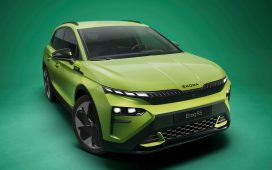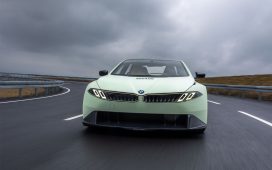Electric vehicles (EVs) are practical for those who commute about 25 minutes each way in the US. However, EVs are more of a burden than a solution for longer trips and in areas that don’t have the charging infrastructure in place. Work trucks and pickups do even more miles, working throughout the day, often pulling large loads, which further drains batteries. Even with a charging network, these vehicles can’t afford to stand around for up to an hour charging their batteries before they can go again.

What’s The Difference Between Hydrogen Fuel Cells And Hydrogen Combustion?
Hydrogen may be one of the fuels of the future, but the ways we’ll use it differ widely.
With only around a decade of sales of new internal combustion engine (ICE) cars left, the lives of people who make a living driving trucks and vans look set to get more complex. Luckily, there is another solution that is gaining traction – hydrogen (H2). Still in its infancy and brought into the public eye thanks to the Toyota Mirai, it allows for EVs with fuel cells that can be replenished in minutes. Hydrogen can also be used as a source for combustion and can theoretically increase the lifespan of the traditional engine. Below, we look at a few of the most promising hydrogen combustion-powered vehicles and concepts that could preview the future of hydrogen combustion.
Differences Between Hydrogen Fuel Cells And Hydrogen Combustion
Hydrogen is a gas that can be liquefied and then used in different ways to power vehicles. It’s a sustainable fuel, and you fill the tank using the same method we’ve been using for decades. The only difference is that the fuel nozzle needs to be locked in place because hydrogen is stored under pressure. The fuel then goes one of two ways, which we will look into in more depth below. Each method produces water (H2O) as a bi-product, with hydrogen combustion vehicles also emitting nitrogen oxides (NOx).
Hydrogen Fuel Cells
Hydrogen FCEVs have onboard fuel cells that can be filled in minutes. The hydrogen stored in these cells undergoes a chemical reaction, which creates electricity. This electricity is used to charge a battery pack, which is then used to power electric motors. An FCEV is essentially an EV with an onboard generator constantly feeding the battery, so there’s no need to recharge. But unlike vehicles like the Ram Ramcharger, an FCEV uses hydrogen instead of dinosaur juice.
Hydrogen Combustion
Hydrogen combustion is the unlikely hero that would enable the ICE engine to live on into the future, with only minor modifications to make it work in traditional vehicles. Essentially, with a few changes, a standard gas engine can burn H2 instead of gasoline, releasing almost no CO2 (trace amounts). Although H2 as a combustion fuel isn’t as efficient as gas, it eliminates the need for a complicated EV powertrain and requires no intermediate batteries. Crucially, it could also mean the combustion engine could live on for enthusiasts.

Is The Future Of Electrified Pickup Trucks Hydrogen Or Range Extenders?
These two methods hold the key to how electric pickups can become a viable alternative to gas-powered models.
It could also work alongside existing tech, such as hybrid systems. Unfortunately, payload storage is also difficult, like the hydrogen fuel cells above. Fortunately, liquid H2 requires a smaller tank than gaseous H2. Its main drawback is that it must be kept at -253o Celsius / -423o Fahrenheit. Any higher than that, and it would simply evaporate. Since adapting existing engines to hydrogen combustion is possible, it could be the best way yet to harness the fuel to lower direct emissions.
Major Hurdles In Bringing Hydrogen Combustion To Market
Storing H2 is far more complex than gas or diesel. Also, hydrogen as a sustainable (and net-zero carbon) fuel is still up for debate since how the H2 is sourced is usually carbon-intensive, requiring fossil fuels in its production, distribution, and storage. There are various types of hydrogen fuel, commonly referred to as gray, blue, and green. Only the green kind is sourced in a carbon-neutral way, using renewable energy such as wind to separate hydrogen from water.

Hydrogen Isn’t Close To Being A Zero-Emissions Fuel Just Yet
The fuel isn’t the problem, how we harness it is.
The majority of hydrogen production is not produced in this way. In addition, the hydrogen refueling infrastructure for cars and trucks is virtually non-existent. It’s not all bad news, however. Since hydrogen combustion can take advantage of existing engines and the storage tanks are smaller than those used in FCEVs, it could be superior in a carbon-free world, assuming the hydrogen is sourced using renewable energy (and the initial hurdles are overcome). Since companies are working on tanks with special linings, the problem of liquid H2 evaporation could also become a thing of the past.
Let’s take a look at a few modern hydrogen combustion engines.

Add CarBuzz to your Google News feed.
Alpine Alpenglow HY4: The French Take Hydrogen Racing
|
Alpine Alpenglow HY4 |
|
|---|---|
|
Engine |
2.0-liter turbocharged four-cylinder (hydrogen combustion) |
|
Max RPM |
7,000 rpm |
|
Power |
340 horsepower (hp) |
|
Drivetrain |
Rear-mid-engine, RWD / 7-speed transmission |
|
Hydrogen payload |
13 lb (3 tanks) |
The Alpine Alpenglow is a concept car revealed in 2022 at the Paris Motor Show. It has evolved into the HY4, a functional racing car test bed for Alpine’s hydrogen combustion system. It is also touted to lead to a production variant for the road. Based on an LMP3 racing chassis, the Alpenglow HY4 failed to start at its maiden exhibition run at Spa-Franchorchamps in Belgium this year, but the car missed its maiden outage because of an electrical issue, which meant the car couldn’t start. It’s the most French problem ever.
Alpine is responsible for the retro-inspired Alpine A110 (which wasn’t sold in the US), and two new, sporty, electric SUV models are promised to come to the US in the next few years. The HY4 is an evolving project that is proving the potential of hydrogen as a performance engine with zero direct carbon emissions. If it trickles down into the brand’s road cars, it could help make hydrogen more viable and perhaps enable Renault to introduce the tech in its affordable cars.
AVL Racetech Hydrogen Combustion Engine
|
AVL Racetech H2 Combustion Engine |
|
|---|---|
|
Engine |
2.0-liter turbocharged four-cylinder |
|
Power |
405 hp |
|
Torque |
369 lb-ft of torque |
|
Power density |
203 hp/liter |
Many companies and organizations have realized the potential of hydrogen combustion and are working to get it right. At the end of last year, we looked at the AVL Racetech hydrogen engine, which offers an impressive power output, revealing the capability of hydrogen combustion as a format for performance cars. Unlike many other hydrogen combustion engines, which function using a lean-burn principle with a high level of excess air, this engine, produced in Graz, Austria, used only a slight lean-burn setup to provide more power.

Hydrogen Combustion Toyota GR Corolla Literally Sucks Carbon From The Air As It Drives
This was debuted by Toyota’s Rookie Racing motorsports team in the hydrogen-powered hot hatch.
It achieved this with the help of water injection to increase boost pressure and provide additional cooling. Like Toyota’s patent in the section below, water injection looks to be an integral part of making hydrogen combustion work. This is because it can help regulate the combustion, which produces a lot of heat in H2 engines. As we can see in the table above, this engine produces over 200 hp per liter, which is a substantial number indeed. It’s more than a Bugatti Chiron, which uses a cutting-edge, 8.0-liter, quad-turbocharged W16. This concept was focused on racing, but it is possible that AVL which is a leading mobility technology company involved in engineering, simulation, and testing – will be able to put this technology into practice so that hydrogen combustion can improve and advance globally.
Toyota GR H2 Racing Concept
Toyota, a long-time proponent of hydrogen as a fuel source, has another exciting project that hopes to prove hydrogen’s potential in the demanding racing world. Like the Alpenglow, the Toyota GR H2 concept operates on the same hydrogen combustion principles but pairs the engine with a hybrid system. The GR H2 was unveiled last year just ahead of the 24 Hours of Le Mans. Toyota did not reveal output figures, but we know that the GR H2 is also equipped with a hybrid component to boost the output of the hydrogen combustion engine.

Toyota Files Patent For Water-Cooled Hydrogen Combustion Engine
It appears to be a high-performance engine.
The organizers of Le Mans have proposed that hydrogen combustion engines will be able to compete from 2026 in the hydrogen class alongside hydrogen fuel cell vehicles. This could be a great way to showcase the differences between the two methods of hydrogen power. We also know that Toyota filed a patent for a new water-injected hydrogen combustion engine design last year, which injects water into the intake ports to cool the engine and control abnormal combustion. Since technology from racing cars can often trickle down to road-going cars, this patent and the GR H2 suggest that Toyota is keeping an eye on a future that isn’t just made of EVs.
2023 Yamaha / Toyota Hydrogen Combustion Concept
This is an example of a hydrogen engine rather than a complete car, but it shows hope for the technology in terms of performance and automakers’ commitment to hydrogen. It was first unveiled in November of last year when the five companies of Kawasaki Heavy Industries, Subaru Corporation, Toyota Motor Corporation, Mazda Motor Corporation, and Yamaha Motor announced that they would begin discussions for conducting collaborative research into possible avenues for expanding the range of fuel options for internal combustion engines in the quest for carbon neutrality.
Yahama also revealed a hydrogen combustion derivative of the Lexus RC F’s 50-liter V8. Built for Toyota. It features modifications to the injectors, cylinder heads, intake manifold, and more to produce 450 hp at 6,800 rpm and a maximum of 398 lb-ft of torque at 3,600 rpm. Yahama’s engine compares well with the 2024 Lexus RC F coupe, which makes 472 hp and 395 lb-ft. Other interesting Yamaha hydrogen products include the Tricera three-wheeled EV and the YXZ1000R, the latter of which is a hydrogen-powered buggy. They were showcased at the 2023 Japan Mobility Show. Although these are all concepts, they could trickle down into tomorrow’s mainstream vehicles.
NamX / Pininfarina HUV (Hydrogen Utility Vehicle)
Jointly designed by Pininfarina and designer Thomas de Loussac, we have the NamX (New Automotive and Mobility eXploration) HUV. Although its name is perhaps a little lackluster, the design is sharp, as you would expect from Pininfarina. Revealed in 2022, the startup NamX’s concept centers around a luxury SUV platform with an exciting feature: a main hydrogen tank with six removable, smaller hydrogen capsules.
These could be hot-swapped at a station (CapXtores) or delivered to quickly replenish the NamX HUV’s range, which is around 500 miles. At its inception, the concept’s power output was claimed to range from 300-550 hp, thanks to a fuel cell setup. Later, the car’s design swapped over to a 6.2-liter V8 ICE engine. Since the vehicle uses hydrogen combustion, it produces no direct CO2, only H20 vapor and NOx, like all the other examples. There are no other confirmed specifications for the HUV, but the startup claims sales marketing material will surface around 2026.
The Forward March Of Hydrogen
As we can see, there is interest on multiple fronts in hydrogen, with various concepts and projects in the works. Hydrogen has made headlines thanks to the Toyota Mirai and H2 fuel cells. But as we’ve seen, combining the tried and tested ICE engine with a zero direct carbon fuel source is the way forward for hydrogen. The technology needs refining and a lot of growth and investment, but big companies are doing the opposite by shutting hydrogen fuel stations down.
Hydrogen also needs to be made greener since it is currently not any more sustainable than other methods, but if ICE can live on past the bans in place for new gas/diesel engines, then the production methods and tech might find more traction.













